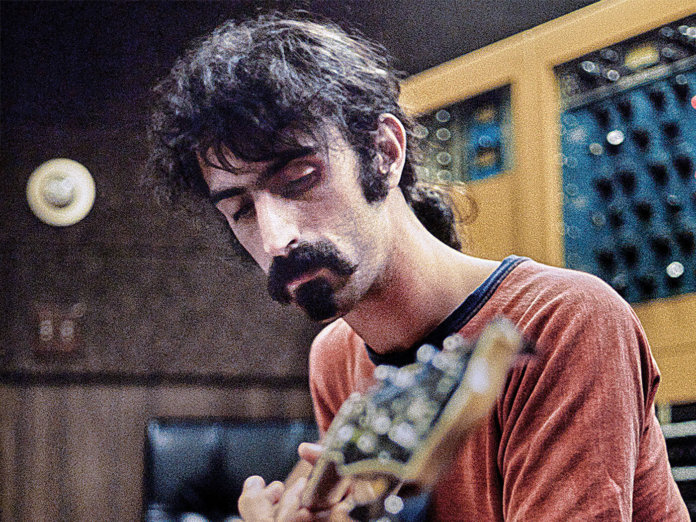You might well conclude that in 1969 the mere presence of Frank Zappa and Captain Beefheart could turn the trees purple. Pedants will insist their records of that year looked the way they did because of the use of infra-red film, key to the otherworldly appearance of both Beefheart’s Trout Mask Re...
You might well conclude that in 1969 the mere presence of Frank Zappa and Captain Beefheart could turn the trees purple. Pedants will insist their records of that year looked the way they did because of the use of infra-red film, key to the otherworldly appearance of both Beefheart’s Trout Mask Replica (produced by Zappa) and Zappa’s Hot Rats (featuring Beefheart). The more sensible, however, know all this was more the result of personal chemistry than photographic alchemy.
Zappa in 1969 seemed to be re-evaluating his relationship with chaos. Having disbanded the original Mothers Of Invention – the satirical Dadaist garage band he had fronted since 1965 – he was now enjoying a role as musician without portfolio. In March he recorded Beefheart’s Trout Mask Replica, a work that sounded abstract but betrayed great discipline. Around the same time released on his Bizarre label was a double album by outsider artist Wild Man Fischer, which sounded abstract and betrayed no discipline, though it did share some of Trout’s blend of audio verité and studio post-production. In November he road-managed Beefheart’s trip to the Amougies festival in Belgium.
At the event, he jammed with Pink Floyd on something a bit like “Interstellar Overdrive”, laying down modal runs with the glassy-eyed band as drenched Europeans looned damply in huge coats. He also met Archie Shepp, whose tenor sound he describes in an archive snippet here as sounding like “pre-heated rats”.
But if he liked unstructured as a place to visit, it wasn’t somewhere that Zappa – a meticulous archivist and editor; a micromanager and painter of the bigger picture – was ever going to want to live. Having voyaged with the Mothers to some strange locations on the fringes of classical, jazz and experimental performance, Hot Rats (his first proper solo album) was made with a tighter agenda.
He retained from the Mothers their keyboard player and musical polymath Ian Underwood (thanked extensively in the notes), but elsewhere he uses a session-hardened personnel. Violinists Jean-Luc Ponty and Don “Sugarcane” Harris, guitarist Shuggie Otis, Max Bennett on bass, the drummers John Guerin, Ron Selico and Paul Humphrey are all on hand to help fulfil his vision.
According to the sleeve, Hot Rats was a “movie in sound, directed by Frank Zappa”. In its original completed form (not included here, but in a 1987 remix on Disc Five, which tells its own weird and echoing story), it’s a succinct flick with some cheesy moments. There are powerfully stated jazz rock themes (like the opening “Peaches En Regalia”), strong guitar action sequences (the sleazy groove of “Willie The Pimp”, voiced by Beefheart; the hard-rocking instrumental “The Gumbo Variations”). There is courtly jazz fusion (“Son Of Mr Green Genes”) and seasick groove (“Little Umbrellas”). It’s fiddly, and proggy, but the rhythm section hold it all together, bringing baseline dirt to material which otherwise might skirt close to telephone hold music. Zappa’s wife referenced the record’s “aroma”, which nails it.
As this new set shows, Zappa’s movie has been waiting for an extended cut, and the six discs here make a documentary-style dive into the album’s development and promotion. It includes tracks recorded, but which didn’t make it (that’s all of Disc Three and also “Natasha”, and the groovy “Bognor Regis”, a cousin of “Willie”). As we get deeper (Discs Five and Six), we reach wacky radio commercials, in-jokey banter with Zappa’s associates the GTOs, as well as “quick mixes” of completed tracks, all of which testify to the inspirational efficiency of Zappa’s working practice. The isolated take of Beefheart’s “Willie” vocal, meanwhile, has the capacity to terrify commuters as a ringtone.
The meat of the thing is on the first two discs, though, as we effectively stand in the room to witness the tracks in development, the jam unbounded. Zappa clearly envisions “Peaches…” as a kind of magic trick, all flourish and misdirection from the song’s compelling piano vamp. “More fills!” he advises the drummer. “Get loose!” We’re listening to someone willing to pursue a glimmer of an idea, but also with an exactingly precise idea of what he wants. A sound you will get used to is Zappa calmly requesting “another, please”.
The musicianship is of such high calibre that the hours of jamming never pall, whether it’s drum solos or a bluesy take – our pre-knowledge of the finished article means that we hear this extra instrumental work as a dynamic pursuit of musical quarry, and not superfluous ornament. Zappa’s infinitely resourceful guitar playing comes out especially well in this regard. The two unedited takes of “Willie The Pimp” find him fiery in his exchange with Don “Sugarcane” Harris, while the half-hour of “Big Legs” – an important stop en route to “The Gumbo Variations” – is filled with bluesy grit as well as jazzy upper-register flourish.
An artist given to precise classifications of his musical universe, Zappa often worked at an ironic distance, designating whole strands of his work as “uncommercial” – mindful of the cultural norms into which his work would land. What’s so engaging about Hot Rats, and about The Hot Rats Sessions in particular is of Zappa working without that frame of reference. They sound as Zappa seldom does: not over-thinking it, and guilelessly lost in the moment, and in the exuberant joy of the playing.



